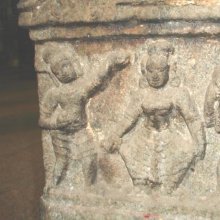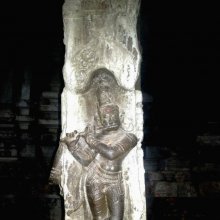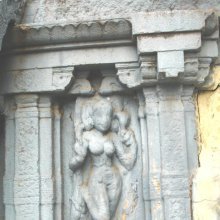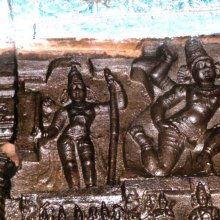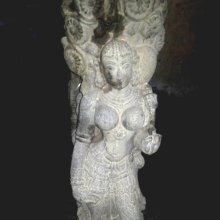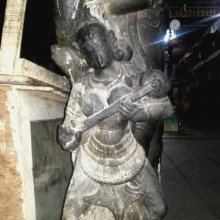Janu, Jānu, Janū, Jāṇu: 31 definitions
Introduction:
Janu means something in Buddhism, Pali, Hinduism, Sanskrit, the history of ancient India, Marathi, Jainism, Prakrit, biology, Tamil. If you want to know the exact meaning, history, etymology or English translation of this term then check out the descriptions on this page. Add your comment or reference to a book if you want to contribute to this summary article.
Images (photo gallery)
(+133 more images available)
In Hinduism
Yoga (school of philosophy)
Source: Wisdom Library: YogaJānu (जानु) is a Sanskrit word referring to the “knee”. It is used in Yoga.
Source: Google Books: Croaking Frogs: (Yoga)Jānu (जानु) refers to the “knees” representing one of the sixteen vital centres of the body (i.e., ādhāra), according to the Jyotsnā 3.73 (Cf. Gorakṣaśataka 14 and Svātmārāma’s Haṭhapradīpikā 3.72).—In Haṭhayoga, ādhāra refers to a vital point of the body, a seat of vital function. Jyotsnā verse 3.73 cites a passage attributed to Gorakṣa listing the ādhāras as [e.g., jānu (knees), ...]. The Haṭhapradīpikā refers to sixteen ādhāras but does not name them or explain what they are. The Gorakṣaśataka also refers to sixteen ādhāras as something the Yogī should be familiar with, but does not name them.

Yoga is originally considered a branch of Hindu philosophy (astika), but both ancient and modern Yoga combine the physical, mental and spiritual. Yoga teaches various physical techniques also known as āsanas (postures), used for various purposes (eg., meditation, contemplation, relaxation).
Purana and Itihasa (epic history)
Source: archive.org: Shiva Purana - English TranslationJānu (जानु) refers to the “knees”, according to the Śivapurāṇa 2.4.10 (“Boasting of Tāraka”).—Accordingly, as Tāraka-Asura fought with Kārttikeya: “[...] They were equally good adepts in fighting. Each wanted to kill the other. They utilised all their power. With the edges of spears they hit each other. They hit or cut each other’s head, neck, thighs, knees (jānu), hips, heart, chest and the back. They continued the fight swaggering and vaunting with heroic words. They were experts in different tactics of warfare. They were equally strong. They desired to kill each other. [...]”.
Source: Cologne Digital Sanskrit Dictionaries: The Purana IndexJanu (जनु).—One of the two Piśācas, who met Yakṣa, the son of Khaśā.*
- * Vāyu-purāṇa 69. 113.

The Purana (पुराण, purāṇas) refers to Sanskrit literature preserving ancient India’s vast cultural history, including historical legends, religious ceremonies, various arts and sciences. The eighteen mahapuranas total over 400,000 shlokas (metrical couplets) and date to at least several centuries BCE.
Ayurveda (science of life)
Source: Wisdom Library: Āyurveda and botanyJānu (जानु) is the name of a specific marma (vital points) of the human body, according to the Aṣṭāṅgahṛdaya-saṃhitā. When affected severely, these marmas causes death. The commonly accepted number of marmas in the human body, as described in the Suśruta-saṃhita, is 107 divided into 5 categories: the muscular, vascular, ligament, bone and joints.
The Aṣṭāṅgahṛdaya-saṃhitā by Vāgbhaṭa is a classical Sanskrit treatise dealing with Āyurveda dating from the 6th-century. Together with the Suśruta-saṃhitā and the Caraka-saṃhita, it is considered one of the three main Indian medical classics
Source: gurumukhi.ru: Ayurveda glossary of termsJānu (जानु):—Knee. The anterior aspect of the leg at the articulation of femur and tibia

Āyurveda (आयुर्वेद, ayurveda) is a branch of Indian science dealing with medicine, herbalism, taxology, anatomy, surgery, alchemy and related topics. Traditional practice of Āyurveda in ancient India dates back to at least the first millenium BC. Literature is commonly written in Sanskrit using various poetic metres.
Shaivism (Shaiva philosophy)
Source: academia.edu: The Śaiva Yogas and Their Relation to Other Systems of YogaJānu (जानु, “knee”) refers to one of the sixteen types of “locus” or “support” (ādhāra) according to the Netratantra. These ādhāras are called so because they “support” or “localise” the self and are commonly identified as places where breath may be retained. They are taught in two different setups: according to the tantraprakriyā and according to the kulaprakriyā. Jānu belongs to the latter system.
Source: Brill: Śaivism and the Tantric TraditionsJānu (जानु) refers to the “knees” representing one of the nine Granthis (‘knots’ or ‘joints’), according to verse 4.497ff of the Brahmayāmala-tantra (or Picumata), an early 7th century Śaiva text consisting of twelve-thousand verses.—Accordingly, “[...] A series of nine lotuses is visualized situated at points in the body called granthis (knots or joints). These are located at the crown of the head, the forehead, throat, navel, knees (jānu), mouth, heart, genitals, and feet, following the order of their sequence in nyāsa. The eight-petalled lotuses situated therein are loci for installation of the principal nine deities: Kapālīśabhairava, who is installed in the crown lotus, and two sets of four goddesses, the Devīs [i.e., Mahocchuṣmā, to be installed on the knees] and the Dūtīs. [...]”.

Shaiva (शैव, śaiva) or Shaivism (śaivism) represents a tradition of Hinduism worshiping Shiva as the supreme being. Closely related to Shaktism, Shaiva literature includes a range of scriptures, including Tantras, while the root of this tradition may be traced back to the ancient Vedas.
Natyashastra (theatrics and dramaturgy)
Source: Shodhganga: The significance of the mūla-beras (natya)Jānu (जानु, “knees”) refers to one of the nine “minor limbs” (pratyaṅga), which represents a division of Āṅgikābhinaya (gesture language of the limbs) as used within the classical tradition of Indian dance and performance, also known as Bharatanatyam.—Āṅgika-abhinaya is the gesture language of the limbs. Dance is an art that expresses itself through the medium of body, and therefore, āṅgikābhinaya is essential for any dance and especially for any classical dance of India. Pratyaṅgas or the minor limbs consist of shoulders, shoulder blades, arms, back, thighs and calves; at times the wrists, knees [viz., Jānu] and elbows are also counted among minor limbs.

Natyashastra (नाट्यशास्त्र, nāṭyaśāstra) refers to both the ancient Indian tradition (shastra) of performing arts, (natya—theatrics, drama, dance, music), as well as the name of a Sanskrit work dealing with these subjects. It also teaches the rules for composing Dramatic plays (nataka), construction and performance of Theater, and Poetic works (kavya).
Shaktism (Shakta philosophy)
Source: Google Books: ManthanabhairavatantramJānu (जानु) refers to the “knees”, corresponding the Arhata (i.e. Jaina) system: one of the sixteen spiritual disciplines (darśana) issued from the limbs of the body of the Goddess, according to the Manthānabhairavatantra, a vast sprawling work that belongs to a corpus of Tantric texts concerned with the worship of the goddess Kubjikā.—[...] All spiritual disciplines, whatever the tradition, are necessarily grounded in the same energy of the Śāmbhava state. They issue, as the texts put it, from the limbs of the body of the goddess who is this energy. These range from the lowest extremity—the left big toe—where Buddhism originates, to the highest—the End of Sixteen—where the Śāmbhava state is attained which is the source of the Kubjikā tradition. The systems (darśana) and their corresponding places of origin in the Goddess’s body are as follows: [2) Arhata (i.e. Jaina)—jānu, ...].

Shakta (शाक्त, śākta) or Shaktism (śāktism) represents a tradition of Hinduism where the Goddess (Devi) is revered and worshipped. Shakta literature includes a range of scriptures, including various Agamas and Tantras, although its roots may be traced back to the Vedas.
Vastushastra (architecture)
Source: Brill: Śaivism and the Tantric Traditions (architecture)Jānu (जानु) [=jānuja?] refers to the “knees”, according to the Devyāmata (in the section śalyoddhāra-paṭala or “excavation of extraneous substances”).—Accordingly, “[...] If [someone] is seen to scratch his knee (jānu-kaṇḍūya—jānukaṇḍūyato dṛṣṭvā), there is an extraneous thing, i.e. a stump or a knee bone (jānuja) at a depth of one cubit. [The officiant] should remove it. If [someone] touches his shank, [the officiant] should prognosticate a bone of the shank [at a depth of] eleven digits underground in that place. There is no doubt about this. [...]”.

Vastushastra (वास्तुशास्त्र, vāstuśāstra) refers to the ancient Indian science (shastra) of architecture (vastu), dealing with topics such architecture, sculpture, town-building, fort building and various other constructions. Vastu also deals with the philosophy of the architectural relation with the cosmic universe.
Ganitashastra (Mathematics and Algebra)
Source: archive.org: Hindu MathematicsJānu (जानु) represents the number 2 (two) in the “word-numeral system” (bhūtasaṃkhyā), which was used in Sanskrit texts dealing with astronomy, mathematics, metrics, as well as in the dates of inscriptions and manuscripts in ancient Indian literature.—A system of expressing numbers by means of words arranged as in the place-value notation was developed and perfected in India in the early centuries of the Christian era. In this system the numerals [e.g., 2—jānu] are expressed by names of things, beings or concepts, which, naturally or in accordance with the teaching of the Śāstras, connote numbers.

Ganitashastra (शिल्पशास्त्र, gaṇitaśāstra) refers to the ancient Indian science of mathematics, algebra, number theory, arithmetic, etc. Closely allied with astronomy, both were commonly taught and studied in universities, even since the 1st millennium BCE. Ganita-shastra also includes ritualistic math-books such as the Shulba-sutras.
In Buddhism
Mahayana (major branch of Buddhism)
Source: Wisdom Library: Maha Prajnaparamita SastraJānu (जानु) refers to the “knees” of the Buddha, to which his rays (raśmi) might return after emission, according to Mahāprajñāpāramitāśāstra (chapter XIV). According to the Avadānaśataka and Divyāvadāna, it is a custom that, at the moment when the Buddha Bhagavats show their smile, blue, yellow, red and white rays flash out of the Bhagavat’s mouth, some of which go up and some of which go down. Those that go down penetrate into the hells (naraka); those that go up penetrate to the gods from the Cāturmahārājikas up to the Akaniṣṭas. Having travelled through the trisāhasramahāsāhasralokadhātu, the rays return to the Bhagavat from behind. According as to whether the Buddha wishes to show such-and-such a thing, the rays return to him by a different part of the body.
The returning of the rays into the knees (jānu) of the Buddha predicts a birth among men (manuṣyopapatti).

Mahayana (महायान, mahāyāna) is a major branch of Buddhism focusing on the path of a Bodhisattva (spiritual aspirants/ enlightened beings). Extant literature is vast and primarely composed in the Sanskrit language. There are many sūtras of which some of the earliest are the various Prajñāpāramitā sūtras.
India history and geography
Source: Cologne Digital Sanskrit Dictionaries: Indian Epigraphical GlossaryJānu.—(IE 7-1-2), ‘two’. Note: jānu is defined in the “Indian epigraphical glossary” as it can be found on ancient inscriptions commonly written in Sanskrit, Prakrit or Dravidian languages.

The history of India traces the identification of countries, villages, towns and other regions of India, as well as mythology, zoology, royal dynasties, rulers, tribes, local festivities and traditions and regional languages. Ancient India enjoyed religious freedom and encourages the path of Dharma, a concept common to Buddhism, Hinduism, and Jainism.
Biology (plants and animals)
Source: Google Books: CRC World Dictionary (Regional names)Janu in India is the name of a plant defined with Sorghum bicolor in various botanical sources. This page contains potential references in Ayurveda, modern medicine, and other folk traditions or local practices It has the synonym Holcus sudanensis (Piper) L.H. Bailey (among others).
Example references for further research on medicinal uses or toxicity (see latin names for full list):
· Species Plantarum
· Prodromus stirpium in horto ad Chapel Allerton vigentium. (1796)
· Molecular Ecology (2143)
· Observationes Botanicae (1781)
· Am. Journal of Botany (1757)
· Taxon (2000)
If you are looking for specific details regarding Janu, for example chemical composition, side effects, diet and recipes, extract dosage, health benefits, pregnancy safety, have a look at these references.

This sections includes definitions from the five kingdoms of living things: Animals, Plants, Fungi, Protists and Monera. It will include both the official binomial nomenclature (scientific names usually in Latin) as well as regional spellings and variants.
Languages of India and abroad
Pali-English dictionary
Source: BuddhaSasana: Concise Pali-English Dictionaryjāṇu : (m.) the knee.
Source: Sutta: The Pali Text Society's Pali-English DictionaryJānu, (nt.) (Vedic jānu=Gr. gόnu, Lat. genu, Goth. , Ohg. , etc. kniu, E. knee) (also as jaṇṇu(ka), q. v.) the knee J. II, 311; IV 41Q VI, 471Q DA. I, 254.

Pali is the language of the Tipiṭaka, which is the sacred canon of Theravāda Buddhism and contains much of the Buddha’s speech. Closeley related to Sanskrit, both languages are used interchangeably between religions.
Marathi-English dictionary
Source: DDSA: The Molesworth Marathi and English Dictionaryjaṇū (जणू).—conj (jānē S or jāṇaṇēṃ) As if; as it were; seemingly; methinks, meseems. Ex. mukha disatēṃ jaṇū candra ugavalā; hā paṇḍita jaṇū kīṃ sūryaca.
--- OR ---
jāṇū (जाणू).—conj (Or jaṇū. From jāṇaṇēṃ) As if; as it were; seemingly; like as; methinks.
--- OR ---
jānu (जानु).—m S The knee.
--- OR ---
jānū (जानू).—n ( H) jānhavīṃ or jānhavēṃ n Commonly jānavēṃ.
Source: DDSA: The Aryabhusan school dictionary, Marathi-Englishjaṇū (जणू).—conj As if; it were; methinks.
--- OR ---
jāṇū (जाणू) [-ṇō, -णो].—conj As if, as it were, seemingly.
--- OR ---
jānu (जानु).—m The knee.
Marathi is an Indo-European language having over 70 million native speakers people in (predominantly) Maharashtra India. Marathi, like many other Indo-Aryan languages, evolved from early forms of Prakrit, which itself is a subset of Sanskrit, one of the most ancient languages of the world.
Sanskrit dictionary
Source: DDSA: The practical Sanskrit-English dictionaryJanu (जनु) or Janū (जनू).—f. Birth, production.
--- OR ---
Jānu (जानु).—n. [jan-ñuṇ] The knee; जानुम्यामवनिं गत्वा (jānumyāmavaniṃ gatvā) kneeling (or falling on one's knees) on the ground.
Source: Cologne Digital Sanskrit Dictionaries: Shabda-Sagara Sanskrit-English DictionaryJanu (जनु).—f.
(-nuḥ) Birth. E. jan to be born, u Unadi affix; also with ū affix janū f.
(-nūḥ)
--- OR ---
Jānu (जानु).—m.
(-nuḥ) The knee. E. jan to be produced, (walking, motion.) ñun Unadi aff.
Source: Cologne Digital Sanskrit Dictionaries: Benfey Sanskrit-English DictionaryJānu (जानु).— (for original janvant), n. and m. The knee, [Suśruta] 1, 348, 16.
Source: Cologne Digital Sanskrit Dictionaries: Cappeller Sanskrit-English DictionaryJānu (जानु).—[neuter] ([masculine]) knee.
Source: Cologne Digital Sanskrit Dictionaries: Monier-Williams Sanskrit-English Dictionary1) Janu (जनु):—[from janīya] f. = nū, [cf. Lexicographers, esp. such as amarasiṃha, halāyudha, hemacandra, etc.]
2) [v.s. ...] the soul, [Demetrius Galanos’s Lexiko: sanskritikes, anglikes, hellenikes]
3) [v.s. ...] cf. sa-.
4) Janū (जनू):—[from janīya] f. ([cf. Lexicographers, esp. such as amarasiṃha, halāyudha, hemacandra, etc.]) See nus.
5) Jānu (जानु):—n. (rarely m., [Mahābhārata iv, 1115; Rājataraṅgiṇī iii, 345]) the knee, [Ṛg-veda x, 15, 6; Atharva-veda ixf.; Vājasaneyi-saṃhitā] etc. (nubhyām avaniṃ-√gam ‘to fall to the ground on one’s knees’ [Mahābhārata, xiii, 935])
6) (as a measure of length) = 32 Aṅgulas, [Śulba-sūtra]
7) cf. γόνυ [Latin] genu; [Gothic] kniu; [German] Knie.
Source: Cologne Digital Sanskrit Dictionaries: Yates Sanskrit-English Dictionary1) Janu (जनु):—(nuḥ) 1. f. Birth.
2) Jānu (जानु):—(nuḥ) 2. m. The knee.
Source: DDSA: Paia-sadda-mahannavo; a comprehensive Prakrit Hindi dictionary (S)Jānu (जानु) in the Sanskrit language is related to the Prakrit word: Jāṇu.
[Sanskrit to German]
Sanskrit, also spelled संस्कृतम् (saṃskṛtam), is an ancient language of India commonly seen as the grandmother of the Indo-European language family (even English!). Closely allied with Prakrit and Pali, Sanskrit is more exhaustive in both grammar and terms and has the most extensive collection of literature in the world, greatly surpassing its sister-languages Greek and Latin.
Prakrit-English dictionary
Source: DDSA: Paia-sadda-mahannavo; a comprehensive Prakrit Hindi dictionary1) Jāṇu (जाणु) in the Prakrit language is related to the Sanskrit word: Jānu.
2) Jāṇu (जाणु) also relates to the Sanskrit word: Jñāyaka.
2) Jāṇu has the following synonyms: Jāṇua.
Prakrit is an ancient language closely associated with both Pali and Sanskrit. Jain literature is often composed in this language or sub-dialects, such as the Agamas and their commentaries which are written in Ardhamagadhi and Maharashtri Prakrit. The earliest extant texts can be dated to as early as the 4th century BCE although core portions might be older.
Kannada-English dictionary
Source: Alar: Kannada-English corpusJāṇu (ಜಾಣು):—[noun] = ಜಾಣತನ [janatana].
--- OR ---
Jānu (ಜಾನು):—[noun] the joint between the lower part of the human leg and the thigh; the knee.
Kannada is a Dravidian language (as opposed to the Indo-European language family) mainly spoken in the southwestern region of India.
Tamil dictionary
Source: DDSA: University of Madras: Tamil LexiconJānu (ஜாநு) noun < jānu. Knee; முழங்கால். ஜாநுவரை நீண்ட பாஹுக்கள். [muzhangal. januvarai ninda pahukkal.]
Tamil is an ancient language of India from the Dravidian family spoken by roughly 250 million people mainly in southern India and Sri Lanka.
See also (Relevant definitions)
Starts with (+45): Jainumde, Janu gaddi, Janu polari, Janu-polari, Janua, January, Janucalana, Janudadhna, Janudaghna, Janudaghnambhas, Janudaghne, Janugaddi, Janugata, Januhpaddhati, Januja, Janujangha, Janujanghapotari, Januka, Janukanduya, Janukapalika.
Ends with (+56): Adhijanu, Adhojanu, Ajanu, Amtarbijanu, Antarjanu, Arjanu, Asamabijanu, Asitajanu, Bahirjanu, Bali-janu, Bhagnajanu, Bhimajanu, Bijanu, Bondajanu, Dakshinajanu, Dhumrajanu, Dighajanu, Dulki-janu, Gaddi janu, Gaddi-janu.
Full-text (+132): Janus, Angajanus, Jnu, Pragatajanu, Janumandala, Januphalaka, Antarjanu, Januvijanu, Janusandhi, Bhagnajanu, Adhojanu, Jano, Prajnu, Januhpaddhati, Bali-janu, Januprahritika, Sato-janu, Janushiras, Janujangha, Adhijanu.
Relevant text
Search found 19 books and stories containing Janu, Jānu, Jaṇu, Jānū, Janū, Jāṇū, Jaṇū, Jāṇu, Jaanu; (plurals include: Janus, Jānus, Jaṇus, Jānūs, Janūs, Jāṇūs, Jaṇūs, Jāṇus, Jaanus). You can also click to the full overview containing English textual excerpts. Below are direct links for the most relevant articles:
Sahitya-kaumudi by Baladeva Vidyabhushana (by Gaurapada Dāsa)
Text 10.217 < [Chapter 10 - Ornaments of Meaning]
Text 4.76 < [Chapter 4 - First-rate Poetry]
Garga Samhita (English) (by Danavir Goswami)
Verses 1.7.24-26 < [Chapter 7 - Description of the Conquest of All Directions]
Verse 2.22.37 < [Chapter 22 - The Rāsa-dance Pastime]
Verse 1.13.21 < [Chapter 13 - The Liberation of Pūtanā]
Chaitanya Bhagavata (by Bhumipati Dāsa)
Verse 2.8.175 < [Chapter 8 - The Manifestation of Opulences]
Verse 1.4.65 < [Chapter 4 - Name-giving Ceremony, Childhood Pastimes, and Thieves Kidnap the Lord]
Verse 1.2.214 < [Chapter 2 - The Lord’s Appearance]
Rig Veda (translation and commentary) (by H. H. Wilson)
Thou Money! Janus-Faced Goddess < [January – March, 2007]
The Indian Scene < [January 1952]
Reviews < [July – September, 1987]
Puranic encyclopaedia (by Vettam Mani)
